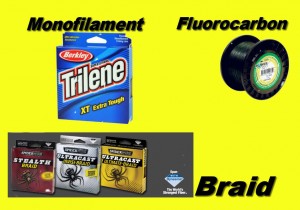By Chris Erwin
The fish are biting, and spring has sprung! This year it has been fast and furious. While we are usually just beginning to see the leaves starting to bud out now, this year we leaped ahead weeks.
In fact, water temperatures are in the range of late April or early May. Some lakes are already seeing spawning activity, and the big bass are cursing shallow water. It remains to be seen if this early weather holds up, but one thing is for sure, if you haven’t got your gear ready it’s time to do it now.

One of the first things you need to do is to clean your reels, lubricate them and replace the line. That brings us to the subject of the line. I have seen people buy a $200 dollar reel, and a $200 rod, then put 99-cent line on it. The line is your connection to the fish and one of the most important tools to become a successful angler. Line weight and type should be understood to improve your chances on the water.
While they are a myriad of lines and types on the market, I have found that they are three types of line that should be in every serious angler’s tackle set up. They have very different properties, and you should understand what line type gives you the best chance to make a connection under each condition.
Let’s break them down so that we can see what line is best to use under varied fishing circumstances.
Monofilament line: Is fishing line made from a single fiber of plastic. It is extruded through different dies to produce strands of line, which is then spun into spools of various thicknesses producing various thickness and tensile strengths.
The common term used to describe the process is called “test” referring to its strength compared to pounds of resistance or pound test. One of the things that this process does is to make this line lighter than water, so the line wants to float. This is important because it makes this type of line the best tool for lures that are top-water lures, or any lure that you want to float to the top in its presentation. In short, we want Monofilament line on our top-water rod.
Braided Line: Some examples here would be Spider Wire, Power Pro Braid, or Daiwa Samurai Braid. While original braids were made from linen and cotton, today’s braids are made from manmade fibers like Dacron, Spectra and Micro-dyneema. Braided line is the strongest line for its diameter. The drawback to this line is it’s opaque in the water, making it visible. However, in dirty water, trolling or heavy brush, this line can be very effective. I use this line on my flipping stick or when cat-fishing since the bait is usually on the bottom.
The third line type has won a very large portion of the fishing line market in the last few years, and one that many anglers still might not understand.
Fluorocarbon: So what is fluorocarbon? The industrial name is polyvinylidene difluoride (PVDF). It is very much like nylon monofilament, but has several advantages. Optical density is lower, which makes the line less easily discernable. The surface is harder so it is more resistant to sharp fish teeth and wear. Furthermore, PVDF does not take up water, and it is resistant to UV-light. It is denser than nylon too, which makes it sinks faster, and it will not float on the water surface. For these reasons, this is the line we want on crankbaits, spinnerbaits, jerkbaits and jigs that braid is not suited for. I spool it on all my rods except for topwater rods and my flipping stick.
When you put the new line on your rods this year, think about what rod you want to do what and put the right tools together to improve your chances to catch that fish of a lifetime.
Till next time
Good fishing!
Chris Erwin is the publisher and founder of Kentucky Angling News available at www.KentuckyAngling.com/magazine.


Be the first to comment